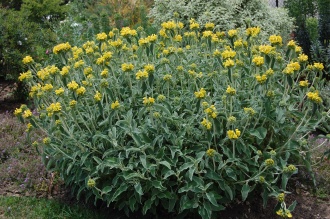Position: Full sun to dappled shade
Flowering period: Late spring to summer
Soil: Moist, well drained
Eventual Height: 1.5m
Eventual Spread: 1.5m
Hardiness: 7a, 7b, 8a, 8b, 9a, 9b, 10a, 10b, 11
Family: Lamiaceae
Phlomis fruticosa is a small evergreen perennial sub-shrub. Its grey green leaves are ovate , up to 10cm long, aromatic and the undersides are covered with fine hairs. Its yellow flowers are up to 3cm long, hooded and appear in whorls in the upper leaf axils in clusters of up to 20. Its fruit is a four to three sided nutlet, topped with hair and is sometimes glabrous. Its root system can be very extensive.
Phlomis fruticosa, commonly known as Jerusalem Sage, is native to south east Europe and parts of Turkey.
The etymological root of the binomial name Phlomis is from the Greek word for mullein (Verbascum), due to the similarity of the leaves. Fruiticosa is derived from the Latin frutex ‘shrub’.
The landscape architect may find Phlomis fruticosa useful as a low maintenance medium height shrub, particularly suited to dryer conditions. Once established this plant is drought tolerant. It is unappealing to deer or rabbits.
Ecologically, Phlomis fruticosa is attractive to bees and other nectar loving insects during its flowering period. The larvae of some Lepidoptera also find its foliage appealing.
The Royal Horticultural Society has given Phlomis fruticosa their prestigious Award of Garden Merit in 1993.
Phlomis fruticosa prefers moist, fertile, well-drained soils. It tolerates most pH of soil.
Phlomis fruticosa requires little maintenance.







Leave a comment